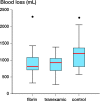Reduction of blood loss in primary hip arthroplasty with tranexamic acid or fibrin spray
- PMID: 21999623
- PMCID: PMC3247881
- DOI: 10.3109/17453674.2011.623568
Reduction of blood loss in primary hip arthroplasty with tranexamic acid or fibrin spray
Abstract
Background and purpose: Previous studies have shown that either fibrin spray or tranexamic acid can reduce blood loss at total hip replacement, but the 2 treatments have not been directly compared. We therefore conducted a randomized, controlled trial.
Patients and methods: In this randomized controlled trial we compared the effect of tranexamic acid and fibrin spray on blood loss in cemented total hip arthroplasty. 66 patients were randomized to 1 of 3 parallel groups receiving (1) a 10 mg/kg bolus of tranexamic acid prior to surgery, (2) 10 mL of fibrin spray during surgery, or (3) neither. All participants except the surgeon were blinded as to treatment group until data analysis was complete. Blood loss was calculated from preoperative and postoperative hematocrit.
Results: Neither active treatment was found to be superior to the other in terms of overall blood loss. Losses were lower than those in the control group, when using either tranexamic acid (22% lower, p = 0.02) or fibrin spray (32% lower, p = 0.02).
Interpretation: We found that the use of tranexamic acid at induction, or topical fibrin spray intraoperatively, reduced blood loss compared to the control group. Blood loss was similar in the fibrin spray group and in the tranexamic acid group. ClinicalTrials.gov identifier: NCT00378872. EudraCT identifier: 2006-001299-19. Regional Ethics Committee approval: 06/S0703/55, granted June 6, 2006.
Figures
References
-
- Benoni G, Lethagen S, Nilsson P, Fredin H. Tranexamic acid, given at the end of the operation, does not reduce postoperative blood loss in hip arthroplasty. Acta Orthop Scand. 2000;71(3):250–4. - PubMed
-
- Benoni G, Fredin H, Knebel R, Nilsson P. Blood conservation with tranexamic acid in total hip arthroplasty: a randomized, double-blind study in 40 primary operations. Acta Orthop Scand. 2001;72(5):442–44. - PubMed
-
- Claeys MA, Vermeersch N, Haentjens P. Reduction of blood loss with tranexamic acid in primary total hip replacement surgery. Acta Chir Belg. 2007;107(4):397–401. - PubMed
-
- Ekbäck G, Axelsson K, Ryttberg L, et al. Tranexamic acid reduces blood loss in total hip replacement surgery. Anesth Analg. 2000;91(5):1124–30. - PubMed
-
- Garneti N, Field J. Bone bleeding during total hip arthroplasty after administration of tranexamic acid. J Arthroplasty. 2004;19(4):488–92. - PubMed
Publication types
MeSH terms
Substances
Associated data
LinkOut - more resources
Full Text Sources
Medical

